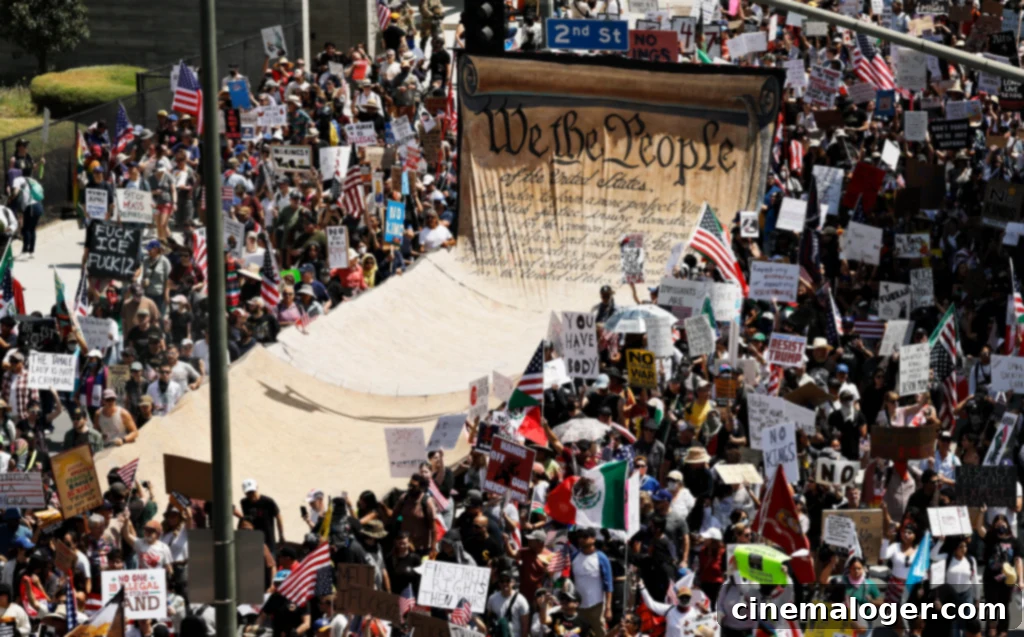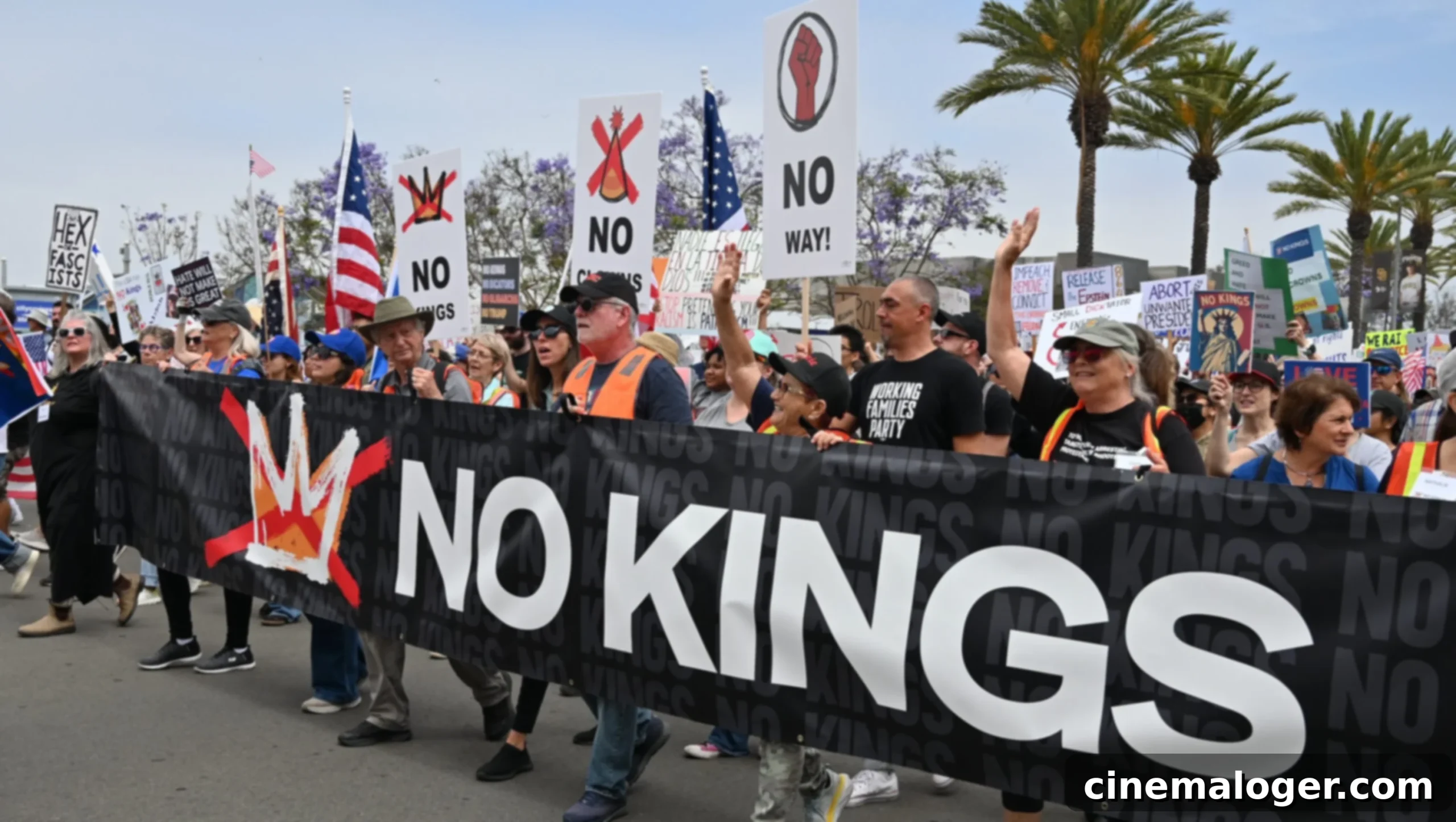The “No Kings” Protest: Unpacking Its Meaning, Massive Turnout, and Enduring Impact Across the U.S.
On June 14, 2025, a wave of unprecedented public dissent swept across the United States. Thousands, and by some estimates millions, of Americans took to the streets under the powerful banner of the ‘No Kings’ protest. This nationwide demonstration served as a clear and emphatic rejection of perceived authoritarian tendencies and an expansive view of executive power. Here, we delve into the core message of this pivotal movement, examine the remarkable turnout it commanded, and consider its lasting implications for the future of American democracy.
The “No Kings” protest, a meticulously coordinated effort, resonated deeply across the United States, drawing substantial crowds in diverse cities and towns, from bustling metropolises to quieter communities.
Conveniently timed on June 14, 2025—a date which notably coincided with President Donald Trump’s 79th birthday—the movement rapidly escalated into one of the most visible and impactful acts of collective public dissent seen in recent memory. What initially emerged as a direct and pointed response to President Trump’s increasingly controversial rhetoric, which many perceived as authoritarian, and a planned military-style birthday parade, swiftly transformed into a resounding coast-to-coast outcry. This event highlighted a significant undercurrent of public concern regarding the balance of power and democratic principles.
The sheer scale of these protests raised a critical question: how widespread were these demonstrations, and how many Americans actively participated to send their unequivocal message? Below, we explore the turnout and the profound significance of this historic day of activism.
Decoding the “No Kings” Protest: What Does the Slogan Signify in America?
The phrase “No Kings” swiftly became the unifying rallying cry, echoing a deeply ingrained American sentiment against any form of monarchical or authoritarian rule. This slogan specifically targeted what many citizens viewed as growing authoritarian tendencies within President Trump’s administration. The urgency surrounding this message intensified following a specific incident in February 2025, when President Trump, in a post on Truth Social, provocatively referred to himself as a “king.” His declaration, “LONG LIVE THE KING!” came as he boasted about overturning New York’s congestion pricing policy, sparking widespread alarm among critics and galvanizing opponents of what they saw as an affront to democratic ideals.
This audacious claim by President Trump took on even greater significance on June 14, 2025. Not only was it his 79th birthday, but it was also the date of a highly publicized military-style parade held in Washington, D.C., which the president attended. For many critics, this event transcended a mere celebration; it was perceived as a glorified, monarch-like spectacle designed to project power and personal grandeur. Such displays further intensified fears concerning the potential for an overreach of executive power, leading to concerns about the erosion of democratic norms and the foundational principle that no leader in a republic should ever act as if above the people or the law.
In direct response to these developments, protests erupted nationwide, unified under the powerful “No Kings” banner. These demonstrations were spearheaded by a coalition of prominent civil society organizations and activist groups, including the 50501 coalition (a broad-based advocacy alliance), the American Civil Liberties Union (ACLU), Indivisible, and the Service Employees International Union (SEIU). Demonstrators vocalized a wide array of concerns, ranging from the prospect of domestic military deployments and aggressive immigration policies to what they viewed as increasingly expansive and unchecked executive actions. At the heart of their argument was a fundamental tenet of American democracy: that no leader, regardless of their popularity or political stature, should ever assume or wield power akin to royalty in a nation founded on the principles of self-governance and checks and balances. The protests underscored a collective desire to safeguard constitutional limits and uphold the spirit of a government by and for the people.

The Unprecedented Reach: How Many ‘No Kings’ Protests Swept the Nation?
The “No Kings” movement distinguished itself not only by its passionate message but also by its astonishing geographical breadth and coordination. This was a truly massive, nationwide undertaking, with coordinated protests materializing in an estimated 2,000 cities and towns. Critically, these demonstrations spanned all 50 states of the U.S., signaling a remarkable unity of purpose and a widespread disquiet that transcended regional and political divides. This extensive reach underscored the pervasive nature of the concerns that fueled the movement, demonstrating that the ‘No Kings’ message resonated with a diverse cross-section of the American populace, from urban centers to rural communities, each committed to upholding the principles of democracy and accountability. The simultaneous nature and vast distribution of these protests amplified their impact, sending an unmistakable message to Washington D.C.
Millions United: How Many People Attended the ‘No Kings’ Protest Across the U.S.?
Estimates concerning the precise number of participants in the ‘No Kings’ protest vary significantly among sources, a common challenge in large-scale demonstrations. However, what remains unequivocally clear is that millions of Americans actively participated nationwide on June 14, 2025, making it an undeniable display of collective will. According to initial reports by The Guardian, an estimated two million or more protesters converged across over 2,000 locations. This figure included particularly robust turnouts in major urban centers, with over 200,000 individuals joining the demonstrations in New York City alone, and more than 100,000 participating in Philadelphia. Los Angeles also reported significant numbers, indicative of a strong presence on the West Coast.
Other influential news outlets, including the Daily Beast and the Financial Times, presented even higher participation figures. Their analyses suggested a total national turnout ranging between four and six million individuals, further emphasizing the extraordinary scale of the movement. These reports highlighted adjusted figures for key cities, citing approximately 50,000 participants in New York City, around 80,000 in Philadelphia, and a staggering 200,000 in Los Angeles. The discrepancies in numbers can often be attributed to varying methodologies used for crowd counting, the dynamic nature of protest events, and the scope of regions covered by different reporting agencies. Regardless of the exact figures, the sheer volume of participation across the country undeniably marked a historic moment in American public protest.
Though the precise numbers may differ across various reputable sources and analytical methods, all accounts converge on one indisputable fact: the “No Kings” protest of June 14, 2025, was unequivocally one of the largest and most significant days of public dissent in the history of the United States. Its massive turnout underscored a profound collective concern for democratic principles and a powerful assertion of the people’s voice against perceived overreach of power, leaving an indelible mark on the nation’s political landscape. This unprecedented display of citizen engagement will undoubtedly be studied and remembered as a critical moment in the ongoing discourse about American democracy and the role of its leadership.
